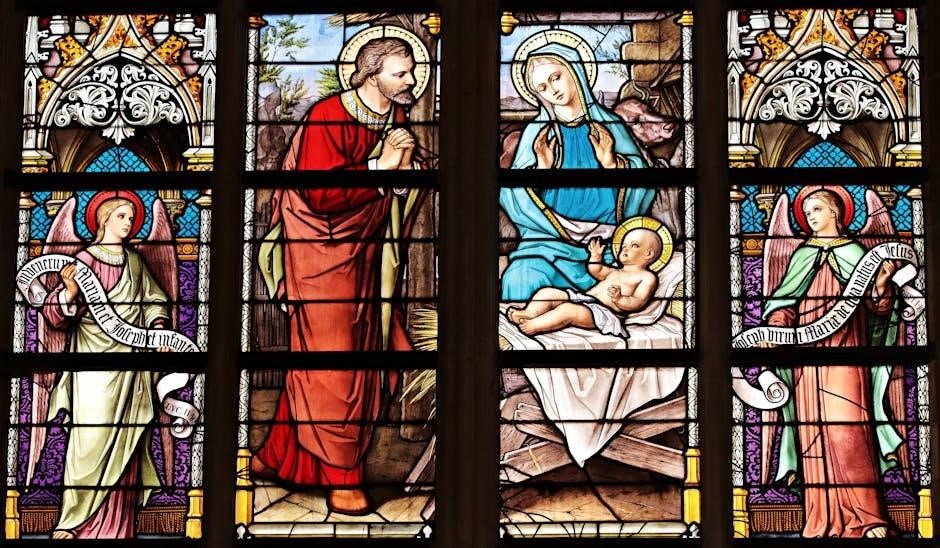“Jesus Paid It All” is a powerful hymn emphasizing redemption through Christ’s sacrifice. Its lyrics, written by Elvina M. Hall and composed by John T. Grape, highlight themes of grace, forgiveness, and victory over sin. The hymn has become a cornerstone in Christian worship, offering a profound reflection on Jesus’ sacrifice. Its enduring relevance and beautiful melody continue to inspire believers, making it a timeless piece of worship music.
Overview of the Hymn
“Jesus Paid It All” is a traditional Christian hymn that reflects on the redemption and forgiveness offered through Jesus Christ. The hymn features four stanzas and a refrain, with a focus on the sacrifice Jesus made to wash away humanity’s sins. Its lyrics, written by Elvina M. Hall, emphasize the transformation from sin’s crimson stain to purity through Christ’s grace. The melody, composed by John T. Grape, complements the profound message, making it a beloved piece in worship. The hymn’s structure and timeless themes have led to various arrangements, including performances by artists like Bill and Gloria Gaither, ensuring its enduring popularity in Christian music.
Historical Background
“Jesus Paid It All” was written by Elvina M. Hall in 1865, with the melody composed by John T. Grape in 1868. The hymn emerged during a period of deep reflection on salvation and Christ’s sacrifice. Hall was inspired by the Bible’s teachings on redemption, particularly 1 Peter 1:18-19 and Revelation 1:5-6. The hymn quickly gained popularity in Christian worship, becoming a testament to the power of grace. Its historical significance lies in its ability to connect believers with the foundational truths of Christianity, making it a timeless and enduring hymn in worship traditions.
Significance in Christian Worship
“Jesus Paid It All” holds profound significance in Christian worship as a declaration of Christ’s redemptive work. The hymn’s vivid imagery of sin’s crimson stain being washed white as snow resonates deeply with believers, emphasizing forgiveness and grace. Its structure, including verses and a refrain, facilitates corporate worship, uniting congregations in praise. The hymn’s themes of sacrifice and victory over sin align with central Christian doctrines, making it a staple in worship services. Its ability to evoke spiritual reflection and gratitude has cemented its place as a cherished hymn, continuing to inspire faith and devotion across generations.

The Lyrics of “Jesus Paid It All”
The hymn’s lyrics, written by Elvina M. Hall, explore themes of redemption and forgiveness, with verses and a chorus emphasizing Christ’s sacrifice and grace through His sacrifice.
Verse 1: “I Hear the Savior Say”
Verse 1 of “Jesus Paid It All” begins with the words, “I hear the Savior say, Thy strength indeed is small.” This line emphasizes human weakness and the need for prayer. It invites believers to seek strength in Christ, highlighting the theme of reliance on divine power. The verse continues, “Child of weakness, watch and pray, find in Me thine all in all,” reinforcing the idea of finding completeness in Jesus. This opening verse sets the tone for the hymn, focusing on trust in Christ’s power and redemption, and its message continues to resonate deeply in Christian worship.
Chorus: “Jesus Paid It All”
The chorus of “Jesus Paid It All” powerfully declares, “Jesus paid it all, all to Him I owe; sin had left a crimson stain, He washed it white as snow.” This refrain emphasizes Christ’s redemptive work, highlighting the transformative power of His sacrifice. The repetition of “Jesus paid it all” underscores the completeness of His atonement, while the imagery of the crimson stain turning white symbolizes forgiveness and purification. The chorus serves as a triumphant declaration of faith, celebrating the freedom and grace found in Christ. Its simplicity and depth make it a beloved and enduring part of Christian worship.
Verse 2: “Lord, Now Indeed I Find”
Verse 2 of “Jesus Paid It All” begins with the lines, “Lord, now indeed I find Thy power, and Thine alone, Can change the leper’s spots and melt the heart of stone.” This verse reflects a deep personal realization of Christ’s transformative power. It emphasizes God’s ability to heal even the most hardened hearts and cleanse the deepest sins. The imagery of the leper’s spots and the heart of stone symbolizes spiritual brokenness and the divine power that overcomes it. This verse underscores the idea of complete reliance on Christ for salvation and redemption, resonating with the hymn’s central theme of grace and restoration. Its message of hope and transformation continues to inspire believers, making it a cherished part of the hymn.
Refrain: “Oh Praise the One Who Paid My Debt”
The refrain, “Oh praise the One who paid my debt,” is a joyful expression of gratitude for Christ’s sacrifice. Sung after each verse, it emphasizes the triumph of Jesus’ payment for humanity’s sins. The lyrics highlight the debt of sin being fully paid and life being raised from death. This refrain serves as a celebration of redemption, encouraging believers to praise and honor Christ for His sacrificial love. Its repetitive nature reinforces the hymn’s central message of salvation and grace, making it a powerful and uplifting element of the hymn that resonates deeply with worshippers.

The Authors and Composers
Elvina M. Hall wrote the heartfelt lyrics in 1865, while John T. Grape composed the melody in 1868. Their collaboration created a timeless hymn celebrating Christ’s redemption and grace.
Elvina M. Hall: The Lyricist
Elvina M. Hall is the celebrated author of the hymn’s profound lyrics. She crafted the words in 1865, focusing on themes of redemption and grace. Hall’s poetic vision emphasizes Jesus’ sacrifice and humanity’s debt to Him. Her verses, such as “I hear the Savior say” and “Sin had left a crimson stain,” vividly depict spiritual transformation. Hall’s work remains a testament to her deep faith and literary skill, resonating with believers across generations. Her contribution to Christian music is immeasurable, making “Jesus Paid It All” a beloved hymn worldwide.
John T. Grape: The Composer
John T. Grape composed the melody for “Jesus Paid It All” in 1868, creating a timeless harmony that complements Elvina M. Hall’s lyrics. His composition, titled “All to Christ,” is noted for its simplicity and emotional depth, enhancing the hymn’s spiritual impact. Grape’s work is widely recognized in Christian music, with the tune becoming synonymous with the hymn’s message of redemption. His contribution has ensured the hymn’s enduring popularity, making it a staple in worship services globally. Grape’s melody continues to inspire and uplift believers, reflecting the hymn’s profound theological themes.

Theological Themes in the Hymn
The hymn explores redemption, grace, and forgiveness through Christ’s sacrifice. It emphasizes Jesus’ payment for sin, cleansing humanity, and believers’ completeness in Him, reflecting profound theological truths.
Redemption and Sacrifice
The hymn “Jesus Paid It All” deeply explores the themes of redemption and sacrifice. It reflects on Christ’s ultimate sacrifice on the cross, where He bore the sins of humanity; The lyrics emphasize how Jesus’ death washed away the crimson stain of sin, symbolizing redemption. This theological foundation underscores the idea that salvation is entirely through Christ’s sacrifice, not human effort. The hymn’s portrayal of redemption highlights God’s grace and the completeness believers find in Him. It serves as a powerful reminder of the profound impact of Christ’s sacrifice on human salvation and eternal life.

Grace and Forgiveness
The hymn “Jesus Paid It All” profoundly highlights the themes of grace and forgiveness. It emphasizes how Jesus’ sacrifice on the cross washed away humanity’s sins, transforming the crimson stain of guilt into purity. The lyrics, such as “Sin had left a crimson stain, He washed it white as snow,” vividly illustrate the transformative power of God’s grace. This forgiveness is not earned but freely given, reflecting the heart of Christian theology. The hymn’s message of grace and forgiveness inspires believers to trust in Christ’s redemptive work, offering hope and spiritual renewal through His unmerited favor and love.
Victory Over Sin
The hymn “Jesus Paid It All” celebrates the triumph of Christ over sin, emphasizing the complete liberation believers experience through His sacrifice. Lyrics like “Sin had left a crimson stain, He washed it white as snow” vividly depict the eradication of sin’s power. The hymn underscores the idea that Christ’s death and resurrection provide victory, enabling believers to live free from sin’s dominion. This theme resonates deeply in Christian worship, inspiring hope and assurance that Jesus’ sacrifice has conquered sin, offering eternal redemption and a life transformed by His grace and power. It calls believers to trust in His victory and live in freedom.

Cultural and Musical Impact
“Jesus Paid It All” has left a lasting impact on Christian music, with its powerful message and timeless melody. Its influence spans generations, inspiring countless arrangements and performances. The hymn’s adaptability has allowed it to remain relevant in modern worship, bridging traditional and contemporary styles. Its enduring popularity reflects its deep resonance with believers, solidifying its place as a cornerstone of Christian musical heritage.
Popularity in Christian Music
“Jesus Paid It All” has endured as a beloved hymn in Christian music, celebrated for its profound lyrics and resonant melody. Its themes of redemption and grace have connected deeply with believers across generations. The hymn’s versatility has led to numerous renditions, from traditional choir performances to contemporary arrangements by artists like Kirk Franklin and Bill and Gloria Gaither. Its widespread use in worship services and its inclusion in hymnals underscore its lasting influence. The hymn’s ability to transcend musical styles has ensured its continued relevance, making it a staple in Christian worship worldwide.
Arrangements and Performances
“Jesus Paid It All” has been beautifully arranged and performed in various musical styles, from traditional hymns to contemporary gospel. Artists like Kirk Franklin and Bill and Gloria Gaither have created powerful renditions, blending heartfelt lyrics with soulful melodies. The hymn’s emotional depth resonates in choir performances, worship bands, and solo acts alike. Its versatility allows it to connect with diverse audiences, preserving its relevance in modern worship. These performances highlight the enduring power of the hymn’s message, ensuring its continued impact in Christian music and worship settings worldwide.
Influence on Modern Worship
“Jesus Paid It All” has profoundly influenced modern worship, bridging traditional and contemporary styles. Its timeless message of redemption resonates deeply, inspiring new arrangements and performances. The hymn’s themes of grace and sacrifice are often incorporated into modern worship songs, reflecting its enduring relevance. Many worship leaders and songwriters draw inspiration from its powerful lyrics, ensuring its legacy in today’s worship culture. Its adaptability to various musical styles has made it a staple in both traditional and modern worship settings, continuing to inspire believers and deepen their connection to Christ’s sacrifice.

Accessing the Lyrics in PDF Format
The lyrics of “Jesus Paid It All” are widely available in PDF format from trusted sources like hymnary.org and other Christian music repositories for easy access and sharing.
Online Resources for Download
Multiple online platforms offer the lyrics of “Jesus Paid It All” in PDF format for free download. Websites like hymnary.org provide authentic lyrics, chord progressions, and historical notes. Other reliable sources include church websites and Christian music repositories, ensuring easy access for worship leaders and believers. These resources often include printable scores and arrangements, making them versatile for various worship settings. Downloading the PDF ensures that the hymn’s powerful message can be shared and studied widely, preserving its legacy for future generations.
Reliable Sources for Authentic Lyrics
The hymn “Jesus Paid It All” is widely available in PDF format from trusted sources. Websites like Hymnary.org and faithconnector.s3.amazonaws.com offer authentic lyrics, ensuring accuracy and accessibility. These platforms provide detailed versions, including verses, choruses, and refrains, along with historical context and musical arrangements. Additionally, many church websites and Christian music repositories share free downloadable PDFs, making it easy to access the hymn for worship, study, or personal reflection. These sources are reliable for obtaining the original lyrics, preserving the hymn’s integrity and legacy.

Using the PDF for Worship and Study
The PDF version of “Jesus Paid It All” is invaluable for worship and study. Churches often use it in service bulletins or projections, ensuring congregations can sing along. For personal devotion, the PDF provides a clear format for reflection on the hymn’s theology. Study groups can analyze its scriptural references, such as 1 Peter 2:24, to deepen understanding. Additionally, the PDF includes musical arrangements, aiding instrumentalists and choirs in performance preparation. Its portability and clarity make it a practical resource for both communal and individual spiritual practices, fostering a connection to the hymn’s enduring message of redemption and grace.
The hymn remains a timeless testament to Christ’s redemption, inspiring faith and worship. Its enduring message of sacrifice and grace continues to resonate in hearts today.
Enduring Relevance of the Hymn
“Jesus Paid It All” remains a timeless hymn, resonating with believers across generations. Its profound message of redemption and grace continues to inspire worship and reflection. The hymn’s themes of sacrifice, forgiveness, and victory over sin are universally relevant, making it a cornerstone in Christian worship; Its simple yet powerful lyrics, combined with its haunting melody, evoke deep emotional and spiritual responses. As a testament to Christ’s love, it bridges traditional and modern worship, reminding all of the transformative power of His sacrifice. Its enduring relevance lies in its ability to speak to the heart of humanity’s need for salvation and hope.
Final Thoughts on Its Message
“Jesus Paid It All” delivers a profound message of redemption and grace, resonating deeply with believers. Its lyrics remind us of Christ’s ultimate sacrifice, inspiring gratitude and devotion. The hymn’s timeless appeal lies in its ability to transcend generations, offering hope and assurance of forgiveness. It calls believers to reflect on their faith and the transformative power of God’s love. The hymn’s enduring message continues to unify worshippers, reinforcing the truth of salvation through Jesus’ sacrifice. Its words inspire awe, humility, and praise, leaving a lasting impact on the hearts of all who encounter it.
